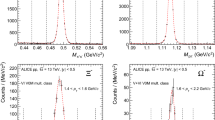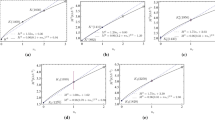Summary
There is not a well-known kinematic theory of masses which can be used to compute masses of observed particles. The theory of mass of conformal relativity in 5 dimensions does promise to fulfil this need. Here we apply its theoretical results tohadrons and successfully fit their masses with a universal lengthl (the size of the 5th dimension) of 1.36 fm. Our fitting scheme shows a trend from which we can predict the observed masses. We conjecture about reasons our fitting distinguishes between hadrons in terms of their quark composition. The value ofl suggests physical interpretations and possible means of detection.
Riassunto
C’è una teoria cinematica delle masse non molto nota che si può usare per calcolare le masse delle particelle osservate. La teoria di massa della relatività conforme in 5 dimensioni non sembra che possa soddisfare questa esigenza. In questo lavoro si applicano i suoi risultati teorici agli adroni e si approssimano con successo le loro masse con una lunghezza universalel (la grandezza della 5a dimensione) di 1.36 fm. Il nostro schema di approssimazione ha un trend dal quale si possono prevedere le masse osservate. Si fanno delle ipotesi sulle ragioni per cui la nostra approssimazione distingue tra adroni in termini della loro composizione di quark. Il valore dil suggerisce interpretazioni fisiche e possibili modi di rilevazione.
Similar content being viewed by others
References
R. L. Ingraham:Nuovo Cimento B,46, 1 (1978).
R. L. Ingraham:Nuovo Cimento B,46, 16 (1978).
R. L. Ingraham:Nuovo Cimento B,46, 217 (1978).
R. L. Ingraham:Nuovo Cimento B,46, 261 (1978).
R. L. Ingraham:Nuovo Cimento B,47, 157 (1978).
R. L. Ingraham:Nuovo Cimento B,50, 233 (1979).
R. L. Ingraham:Nuovo Cimento B,68, 203 (1982).
R. L. Ingraham:Nuovo Cimento B,68, 218 (1982).
R. L. Ingraham:Nuovo Cimento B,27, 293 (1975).
F. Gürsey andS. Orfanidis:Phys. Rev. D,7, 2424 (1972).
V. K. Dobrek, V. B. Petkova, S. G. Petrova andI. T. Todorov:Phys. Rev. D,13, 887 (1976).
For a recent analysis of Kaluza-Klein theories, see ref. (12).
A. Salam andJ. Strathdee:Ann. Phys. (N. Y.),141, 316 (1982).
Cf. discussion on p. 204 of ref. (7).
Frazer (14).
W. R. Frazer:Elementary Particles (Princeton University Press, Princeton, N. J., 1966).
See, for example,M. Jacob andG. F. Chew:Strong Interaction Physics (W. A. Benjamin Inc., New York, N. Y., 1964).
Reference (5).
From ref. (9), p. 294.
E.g., the e.m. coupling between electrons is the same as the e.m. coupling between protons. See ref.(5), p. 178.
T. DeGrand, R. L. Jaffe, K. Johnson andJ. Kiskis:Phys. Rev. D,12, 2060 (1975).
C. E. Carlson, T. H. Hanson andC. Peterson:Phys. Rev. D,27, 1556 (1983)
G. E. Brown andM. Rho:Phys. Lett. B,82, 177 (1979).
Author information
Authors and Affiliations
Additional information
To speed up publication, the author of this paper has agreed to not receive the proofs for correction.
Rights and permissions
About this article
Cite this article
Luna-Acosta, G.A. Fitting of hadron spectrum in 5-dimensional conformal relativity. Nuov Cim A 94, 25–41 (1986). https://doi.org/10.1007/BF02894803
Received:
Published:
Issue Date:
DOI: https://doi.org/10.1007/BF02894803




